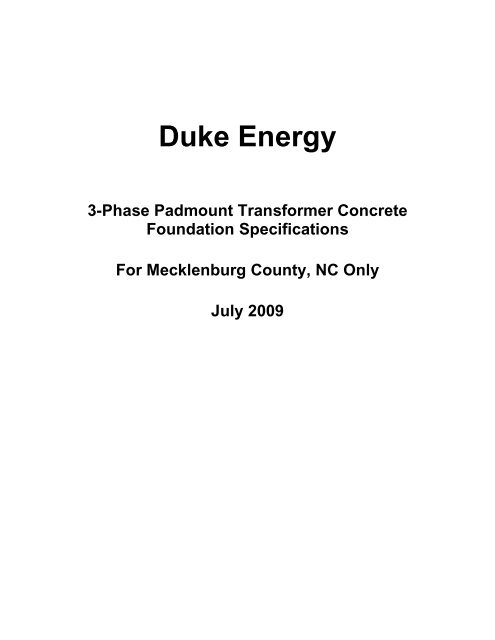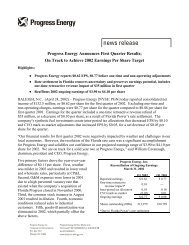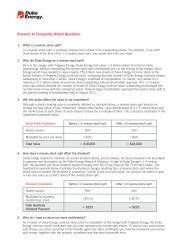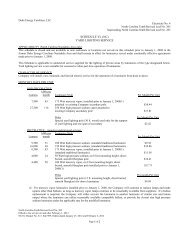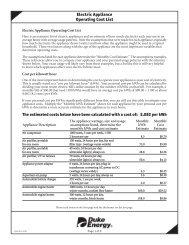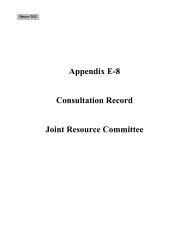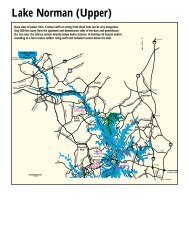3-Phase Padmount Transformer Concrete Foundation - Duke Energy
3-Phase Padmount Transformer Concrete Foundation - Duke Energy
3-Phase Padmount Transformer Concrete Foundation - Duke Energy
You also want an ePaper? Increase the reach of your titles
YUMPU automatically turns print PDFs into web optimized ePapers that Google loves.
<strong>Duke</strong> <strong>Energy</strong><br />
3-<strong>Phase</strong> <strong>Padmount</strong> <strong>Transformer</strong> <strong>Concrete</strong><br />
<strong>Foundation</strong> Specifications<br />
For Mecklenburg County, NC Only<br />
July 2009
Flat Pad and Pit Pad Application and Construction<br />
The information contained in this document has been prepared to assist both <strong>Duke</strong><br />
<strong>Energy</strong> personnel and <strong>Duke</strong> <strong>Energy</strong> customers in the application and construction of<br />
foundations for all 3-phase padmount transformers. This information is intended to<br />
provide clear distinctions between the responsibilities of <strong>Duke</strong> <strong>Energy</strong> and of the<br />
customer. However, in all cases, it is critical to maintain an open dialog between <strong>Duke</strong><br />
<strong>Energy</strong> and the customer regarding conductor quantities, conduit sizes and locations,<br />
connections, and electrical load requirements. This will ensure that the proper<br />
dimensions are used for the concrete transformer foundation.<br />
The “Pit Pad” is preferred for all 3-phase padmount installations. In cases where there<br />
are 3 secondary conductors per phase or fewer AND the conductors are less than or<br />
equal to 400 MCM, a “flat pad” may be considered. The <strong>Duke</strong> <strong>Energy</strong> project<br />
coordinator will make the final decision whether it is permissible to use a “flat pad.”<br />
A separate secondary bus enclosure is required whenever the customer is installing<br />
more than ten (10) 600 MCM or smaller conductors per phase, or more than eight (8)<br />
conductors per phase that are larger than 600 MCM.<br />
Generally, the “SMALL” pad is used for transformers rated 300 KVA and below, and the<br />
“LARGE” pad is used for transformers rated 500 KVA and above. Consider a “LARGE”<br />
pad in applications where the number of customer conduits/conductors exceeds the<br />
window opening restrictions of the “SMALL” pad, and when load growth and/or a<br />
transformer change-out to a larger size is anticipated. In most cases, regardless of the<br />
KVA rating, the air compartment of all currently purchased transformers should cover<br />
the entire window opening of either pad. (There may be some rare exceptions.)<br />
Customer Responsibilities<br />
The customer may choose to construct the transformer pad on site or purchase a<br />
prefabricated unit from a manufacturer. In either case, the customer is responsible for<br />
assuring the pad is manufactured to the requirements provided in this specification.<br />
Listed below are instructions for building a transformer pad on site.<br />
1. Customer is to contact <strong>Duke</strong> <strong>Energy</strong> to inspect pad forms and dimensions prior to<br />
concrete being poured<br />
2. Customer shall supply the concrete mix (as shown in the concrete mix<br />
specifications), welded wire fabric, #4 reinforcing bars, and shall pour the "flat pad"<br />
or "pit pad".<br />
3. The dimensions shall be in accordance with the specifications based on the<br />
transformer KVA size. The thickness of all walls on the "pit pad" shall be a minimum<br />
of 5 - 1/2” thick. The transformer KVA Size is to be specified by <strong>Duke</strong> <strong>Energy</strong>.<br />
<strong>Duke</strong> <strong>Energy</strong> 3-<strong>Phase</strong> <strong>Padmount</strong> <strong>Transformer</strong> <strong>Concrete</strong> <strong>Foundation</strong> Specifications July 2009<br />
1
Customer Responsibilities (continued)<br />
4. Refer to the <strong>Padmount</strong> Building Clearance Standard for the minimum allowable<br />
distance between transformer pads and buildings, building openings and equipment.<br />
There shall be a minimum clearance of 10' from the front of the concrete pad to any<br />
walls, machinery, or other obstacles. If there are multiple transformers or secondary<br />
bus enclosures involved in the installation, there shall be a minimum clearance of 3<br />
feet between all padmount equipment.<br />
5. When a transformer is installed in a vault, the customer shall install a 1" metering<br />
conduit from the secondary compartment of the pit pad to the metering location as<br />
specified by <strong>Duke</strong> <strong>Energy</strong>.<br />
6. Customer shall install the conduit for the primary conductors (as specified for “pit”<br />
pad installations only) as close to the center of the "primary" area as practical. The<br />
"primary" conduit(s) and the customer's "secondary" conduits shall be cut to meet<br />
the dimensions as shown.<br />
Note: The preferred method for installing customer's "secondary"<br />
conduits is shown. An alternative method is for the customer's<br />
conduit to be installed in the side of the pit. If the customer's<br />
switchgear is at a level below the padmount transformer location,<br />
special arrangements must be made to prevent water from<br />
entering the customer's switchgear through the customer's<br />
conduits.<br />
7. Customer shall inform <strong>Duke</strong> <strong>Energy</strong> of the number, size, and type of secondary<br />
conductors that will be installed. (Example: 500 MCM Copper, 600 volt insulated,<br />
four (4) conductors per phase.)<br />
8. Customer must be specific regarding 4-wire (grounded-wye) and 3-wire ("floatingwye")<br />
deliveries. Special metering and grounding considerations may need to be<br />
considered for each of these deliveries. For 3-wire deliveries, a single grounding<br />
conductor (maximum size 1/0) from the customer shall be connected to the copper<br />
grounding ring in the transformer compartment, and the ground strap must be<br />
completely disconnected from the X0 bushing.<br />
Note: 4-wire deliveries and 3-wire deliveries SHALL NOT be provided<br />
from the same transformer. A 4-wire delivery requires the X0<br />
bushing to be grounded, and a 3-wire delivery requires that the X0<br />
bushing be completely disconnected from ground. (These two<br />
conditions cannot be met using a single transformer.)<br />
<strong>Duke</strong> <strong>Energy</strong> 3-<strong>Phase</strong> <strong>Padmount</strong> <strong>Transformer</strong> <strong>Concrete</strong> <strong>Foundation</strong> Specifications July 2009<br />
2
9. It is the responsibility of the customer to provide room for excess secondary cables<br />
when conductors are in parallel. All parallel conductors shall be grouped and<br />
marked by the electrician. There must be no more than 1.5 feet difference between<br />
the shortest and the longest of any parallel cables on any one phase.<br />
<strong>Duke</strong> <strong>Energy</strong> Responsibilities<br />
1. <strong>Duke</strong> <strong>Energy</strong> will supply and install the 10' ground rod prior to the installation of the<br />
padmount transformer.<br />
2. <strong>Duke</strong> <strong>Energy</strong> will install lugs on the secondary conductors and will make the<br />
connections of the secondary conductors to the low voltage spade terminals. Excess<br />
secondary conductor length is the responsibility of the customer as there will be very<br />
little space in the secondary compartment of the transformer to accommodate<br />
excess cable.<br />
<strong>Concrete</strong> Mix Specifications<br />
1. <strong>Concrete</strong> mix used for <strong>Transformer</strong> Pads shall meet the following requirements:<br />
• Minimum 28 day compressive strength of 3,000 psi<br />
• Maximum water / cement ratio of 0.50<br />
• Maximum slump of 4 inches<br />
• Air-entrainment content between 4 and 8 percent<br />
2. <strong>Concrete</strong> shall be afforded adequate cure for a minimum of :<br />
• five (5) days if the ambient temperature is over 70° F, or<br />
• seven (7) days if the ambient average temperature is below 70° F.<br />
3. Adequate cure can be performed by any of the following methods:<br />
• Waterproof membranes<br />
• Sprinkling or Soaking<br />
• Curing Compounds<br />
4. Pad shall be supported on a sub-base of sand, gravel, or crushed stone. The<br />
granular sub-base is to be a minimum of four (4) inches thick and shall be<br />
compacted with a vibratory compactor.<br />
5. Dampen the sub-base prior to concrete placement. At the time of placement, the<br />
sub-base shall not contain standing water.<br />
<strong>Duke</strong> <strong>Energy</strong> 3-<strong>Phase</strong> <strong>Padmount</strong> <strong>Transformer</strong> <strong>Concrete</strong> <strong>Foundation</strong> Specifications July 2009<br />
3
6. The top of the concrete pad must be steel troweled and completely smooth to<br />
prevent “gaps” between the transformer and the surface of the concrete pad.<br />
Installing Conduit in Pit Pads<br />
Conduit for <strong>Duke</strong> <strong>Energy</strong> Primary Cables shall be specified by <strong>Duke</strong> <strong>Energy</strong> and<br />
installed by the customer when pouring the pad. Conduit shall be Schedule 40 and<br />
shall adhere to the following specifications:<br />
Conduit Size Elbow Radius<br />
4” 36”<br />
5” 36”<br />
6” 36”<br />
All conduits shall be installed so the belled end is “up” in the transformer compartment<br />
to minimize damage to the cables during installation.<br />
Customer’s secondary conduits shall not cross or interfere with the primary conduits.<br />
(The customer’s conduit can exit the secondary side either coming out the front, the<br />
right side, or the back.)<br />
The customer’s conduits shall not extend outside the designated “secondary” area of<br />
the window.<br />
<strong>Duke</strong> <strong>Energy</strong> 3-<strong>Phase</strong> <strong>Padmount</strong> <strong>Transformer</strong> <strong>Concrete</strong> <strong>Foundation</strong> Specifications July 2009<br />
4
Small Flat Pad and Pit Pad- Mecklenburg County Only<br />
See<br />
Note<br />
2<br />
82”<br />
Welded Wire Fabric<br />
(6” x 6”) W2 x W2<br />
Maintain 2” cover<br />
from the top of the<br />
concrete.<br />
14” - 24” #4 Reinforcing Bars<br />
6” min (Note 3)<br />
(Primary)<br />
See Note 5<br />
(Secondary)<br />
12” 34” 22”<br />
2”<br />
12”<br />
See<br />
Note<br />
2<br />
1) Pad to be a Minimum<br />
of 5 - 1/2” Thick<br />
2) Shaded area around<br />
pad indicates minimum<br />
clearance from<br />
obstructions.<br />
(Refer to the <strong>Padmount</strong><br />
Clearance Standard for<br />
minimum distances from sides<br />
and back of concrete.<br />
10’ minimum from front<br />
of concrete.)<br />
3) Pit Pad Only<br />
4) Cover bottom of pit<br />
with 6” of gravel.<br />
<strong>Duke</strong> <strong>Energy</strong> 3-<strong>Phase</strong> <strong>Padmount</strong> <strong>Transformer</strong> <strong>Concrete</strong> <strong>Foundation</strong> Specifications July 2009<br />
5<br />
61”<br />
17”<br />
6”<br />
See Note 2<br />
84”<br />
10<br />
Feet<br />
(Drawing<br />
Not To Scale)<br />
SMALL<br />
FLAT PAD<br />
&<br />
PIT PAD<br />
DIMENSIONS<br />
82”<br />
84”<br />
WIDE<br />
LONG<br />
5) Barrier required for pit<br />
pad only. Barrier must<br />
extend to the walls of the<br />
pit, from the top of the pad<br />
to the bottom of the pit<br />
and its top level must be<br />
level with the top of pad.<br />
D09AJM01.CDR
Large Flat Pad and Pit Pad- Mecklenburg County Only<br />
See<br />
Note<br />
2<br />
94”<br />
Welded Wire Fabric<br />
(6” x 6”) W2 x W2<br />
Maintain 2” cover<br />
from the top of the<br />
concrete.<br />
14” - 24” #4 Reinforcing Bars<br />
6” min (Note 3)<br />
(Primary)<br />
See Note 5<br />
(Secondary)<br />
18” 36” 26”<br />
2”<br />
12”<br />
See<br />
Note<br />
2<br />
<strong>Duke</strong> <strong>Energy</strong> 3-<strong>Phase</strong> <strong>Padmount</strong> <strong>Transformer</strong> <strong>Concrete</strong> <strong>Foundation</strong> Specifications July 2009<br />
6<br />
70”<br />
18”<br />
6”<br />
See Note 2<br />
94”<br />
10<br />
Feet<br />
(Drawing<br />
Not To Scale)<br />
LARGE<br />
FLAT PAD<br />
&<br />
PIT PAD<br />
DIMENSIONS<br />
94”<br />
94”<br />
WIDE<br />
LONG<br />
1) Pad to be a Minimum<br />
of 5 - 1/2” Thick<br />
2) Shaded area around<br />
pad indicates minimum<br />
clearance from<br />
obstructions.<br />
(Refer to the <strong>Padmount</strong><br />
Clearance Standard for<br />
minimum distances from sides<br />
and back of concrete.<br />
10’ minimum from front<br />
of concrete.)<br />
3) Pit Pad Only<br />
4) Cover bottom of pit<br />
with 6” of gravel.<br />
5) Barrier required for pit<br />
pad only. Barrier must<br />
extend to the walls of the<br />
pit, from the top of the pad<br />
to the bottom of the pit<br />
and its top level must be<br />
level with the top of pad.<br />
D09AJM02.CDR
Note: Pit Barrier not shown in these drawings for clarity.<br />
<strong>Duke</strong> <strong>Energy</strong> 3-<strong>Phase</strong> <strong>Padmount</strong> <strong>Transformer</strong> <strong>Concrete</strong> <strong>Foundation</strong> Specifications July 2009<br />
7
Note: Pit Barrier not shown in this drawing for clarity.<br />
<strong>Duke</strong> <strong>Energy</strong> 3-<strong>Phase</strong> <strong>Padmount</strong> <strong>Transformer</strong> <strong>Concrete</strong> <strong>Foundation</strong> Specifications July 2009<br />
8
D09AJM03.WMF<br />
Instructions for Building 3-<strong>Phase</strong> <strong>Padmount</strong>ed <strong>Transformer</strong> “Pit Pads”<br />
Step 1 Dig a rectangular shaped hole approximately 40" x 68" and 36" deep. (The<br />
68" side should be to the front.)<br />
Note: The hole indicates the front of the transformer. The pad should be<br />
located so that a minimum of 10' of clearance can be maintained<br />
in front of the transformer and a minimum of 3' of clearance on all<br />
other sides.<br />
Dig The Hole<br />
Step 2 Build two rectangular shaped boxes, open at the top and bottom, from 2x4's<br />
and plywood. The plywood sides of the box should be 36" tall.<br />
<strong>Duke</strong> <strong>Energy</strong> 3-<strong>Phase</strong> <strong>Padmount</strong> <strong>Transformer</strong> <strong>Concrete</strong> <strong>Foundation</strong> Specifications July 2009<br />
9
Window openings for the small 82”x84” Pit Pad<br />
36” Primary<br />
36”<br />
Secondary<br />
17” 17”<br />
34” 22”<br />
Window openings for the large94”x94” Pit Pad<br />
36” Primary<br />
36”<br />
D09AJM06.CDR<br />
Secondary<br />
18” 18”<br />
36” 26”<br />
D09AJM07.CDR<br />
<strong>Duke</strong> <strong>Energy</strong> 3-<strong>Phase</strong> <strong>Padmount</strong> <strong>Transformer</strong> <strong>Concrete</strong> <strong>Foundation</strong> Specifications July 2009<br />
10
Step 3 Set the boxes in the hole and position them so that a minimum of 6" of space<br />
exists between the sides and back of each box and the edge of the hole.<br />
(The space between box and front edge of hole will probably be 10" to 12".)<br />
Trace a line around the bottom outside edge of each box in dirt and then<br />
remove them. Install two (2) conduit elbows in bottom of hole for the primary<br />
conductors as specified by <strong>Duke</strong> <strong>Energy</strong> (belled end up) entering from the<br />
front of hole and placed so they will come up within the outline of each box.<br />
TAPE BOTH ENDS OF CONDUITS COMPLETELY CLOSED.<br />
6” MIN<br />
BOX<br />
OUTLINE<br />
Note: The customer’s secondary conduits should be installed at this<br />
time. If the customer is providing the service conductors to the<br />
transformer, they may elect to enter the secondary box from the<br />
front, back or right side. If <strong>Duke</strong> <strong>Energy</strong> is providing the service<br />
conductors, all conduits must enter from the front of the box. The<br />
1" metering conduit should also be installed at this time if<br />
necessary. Make sure it is in the designated “secondary” area.<br />
PRIMARY SIDE<br />
SECONDARY<br />
SIDE<br />
EDGE OF<br />
HOLE<br />
TOP VIEW FRONT<br />
D09AJM08.CDR<br />
Window Box Placement<br />
Step 4 Fill approximately 6" of dirt in the hole to support elbows. Place the boxes<br />
back in the hole over conduits, positioning them again so a minimum of 6" of<br />
space exists between the back and sides of the hole and the boxes. There<br />
must be 2” of separation between the boxes. The boxes should stick out from<br />
the top of the hole approximately 6" (or the width of a standard 2x6 board).<br />
Make sure conduits enter correctly in primary and secondary boxes.<br />
<strong>Duke</strong> <strong>Energy</strong> 3-<strong>Phase</strong> <strong>Padmount</strong> <strong>Transformer</strong> <strong>Concrete</strong> <strong>Foundation</strong> Specifications July 2009<br />
11
Primary Conduit Installation<br />
D09AJM09.CDR<br />
Step 5 Form the top part of the pad using 2x6 boards using the dimensions as<br />
indicated below.<br />
84”<br />
Note: It may be easier to "level" the boxes with the sides if you lay two<br />
2x4 boards on the top of the side boards so that they cross over<br />
top of each box as shown in Figure 6. Tack these boards onto the<br />
top of each box to ensure sides are the same height as the boxes.<br />
BOX<br />
82”<br />
REAR<br />
FRONT<br />
BOX<br />
6”<br />
<strong>Duke</strong> <strong>Energy</strong> 3-<strong>Phase</strong> <strong>Padmount</strong> <strong>Transformer</strong> <strong>Concrete</strong> <strong>Foundation</strong> Specifications July 2009<br />
12<br />
94”<br />
12” 12”<br />
18”<br />
Small 82” x 84” Pad<br />
BOX<br />
94”<br />
REAR<br />
FRONT<br />
BOX<br />
6”<br />
Large 94” x 94” Pad<br />
12”<br />
D09AJM10.CDR
Figure 6<br />
D09AJM11.CDR<br />
<strong>Duke</strong> <strong>Energy</strong> 3-<strong>Phase</strong> <strong>Padmount</strong> <strong>Transformer</strong> <strong>Concrete</strong> <strong>Foundation</strong> Specifications July 2009<br />
13
Note: CUT OFF ALL ELBOWS 6” ABOVE GRAVEL.<br />
<strong>Concrete</strong> Barrier<br />
Depth Dimensions – Front View<br />
D09AJM12.CDR<br />
<strong>Duke</strong> <strong>Energy</strong> 3-<strong>Phase</strong> <strong>Padmount</strong> <strong>Transformer</strong> <strong>Concrete</strong> <strong>Foundation</strong> Specifications July 2009<br />
14
Plywood Installation<br />
Step 6 Install a piece of plywood inside the hole long enough to reach from one side<br />
of the hole to the other and wide enough to reach from the top of the front 2x6<br />
form to the bottom of the hole. (These dimensions should be approximately<br />
68" x 36".) Tack the plywood to the front of the 2x6 and let the bottom of the<br />
board rest on the ground. Plywood must be thick enough so it won't give at<br />
bottom of hole when the concrete is poured.<br />
Step 7 Fill in the area between plywood and the front of the hole with dirt. Be careful<br />
that plywood doesn't "push in" at bottom. Fill boxes with 6" of gravel.<br />
Step 8 Install reinforcing bars around box in "pit area" and welded wire fabric in "pad<br />
area" to reinforce entire pit pad. (See pages 7 & 8 for more complete details.)<br />
Step 9 Pour concrete "around" the box and "within" the 2x6 forms. (See page 3 for<br />
concrete mix specifications.)<br />
Step 10 Allow concrete to set up, then remove 2x6 forms and box.<br />
<strong>Duke</strong> <strong>Energy</strong> 3-<strong>Phase</strong> <strong>Padmount</strong> <strong>Transformer</strong> <strong>Concrete</strong> <strong>Foundation</strong> Specifications July 2009<br />
15


